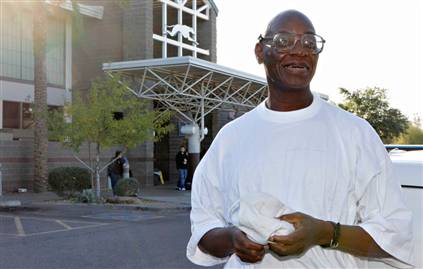We've seen it in television shows like The Practice and in movies like The Shawshank Redemption. We've watched it on the news and read about it in the papers. It happens more often than any of us would like to admit. People go to prison for crimes they did not commit.
And it just happened again on Wednesday. A man who spent 28 years in prison for a crime he didn't commit, a crime that all along he said he didn't commit but for which he was found guilty, was released from federal prison Wednesday.
DNA testing proved that he was the innocent man he said he was.
"We're at a unique point in history now," says Paul F. Enzinna, a partner at D.C. law firm Baker Botts, a member of the Mid-Atlantic Innocence Project. The Innocence Project is a non-profit group whose cause is to free criminals who have been wrongfully convicted. "A lot of people who shouldn't be in prison got there before DNA testing could exonerate them." With DNA testing, those people can be released, pardoned. "DNA is a truth machine that has allowed us to know, with certainty, where the criminal justice system fails."
Donald E. Gates, who walked out of a federal prison in Arizona this week, is now 58. He was 30 years old when he was imprisoned for a rape and murder he didn't commit. How exactly can one apologize for such a life-altering mistake?
It's a question Enzinna and members of the Mid-Atlantic Innocence Project ask daily.
"It's been 20 years since the first exoneration took place," says Enzinna. "In 1989, DNA freed its first wrongly convicted man, [Gary Dotson], who had been convicted of rape." Since then more than 200 wrongfully convicted inmates have been exonerated by DNA; 15 of them were on death row.
One of these wrongly convicted men was Marvin Anderson whom Enzinna himself helped free. In describing what went painfully wrong with Anderson's case Enzinna says, "he was the victim of investigative tunnel vision and plain old fashioned eyewitness misidentification."
Anderson's nightmare began on July 17, 1982 when a black man brutally raped a white woman in Hanover, Virginia. Anderson, who was 18 at the time and worked at nearby Kings Dominion, lived in Hanover. At the time of the rape, Anderson, who had been dating a white woman, was at home with his mother. That Anderson had an alibi didn't seem to matter.
Freed from her attacker, the victim described to police a man fitting Marvin Anderson's description. Enzinna says police later explained to him that Anderson "'was in a situation where he was with a white girl living, married or what have you.' It didn't seem to sit well with the police officer involved in the case that Marvin was involved with a white woman," Enzinna says. The police picked Anderson up for questioning. They didn't have a mug shot of him because he'd never been in trouble. So they went to Kings Dominion, secured his photo ID and used it for the photo line-up. They laid out Anderson's color ID in the center of a mug shot page and surrounded it with five black and white mug shots. It's not hard to guess to which photo the victim's eyes were drawn. Almost immediately she pointed to Anderson's photo, the only color photo and the picture in the center of the page. An hour later, the police lined Anderson up with six other men. Again, police made Anderson stand out. How? There was no one else from the mug shot page in the line-up. Anderson was the only familiar face. "This was the second time the victim was seeing him," Enzinna points out. She wasn't seeing the other men a second time. "[The police] were reinforcing the belief that she was seeing the right person," Enzinna explains.
Anderson was arrested. In less than three hours the jury found Anderson guilty.
His chances of being found not guilty were slim right from the start mostly because the forensic evidence was poor. Enzinna explains, the evidence "could not exclude Anderson because the technician could not ascertain the perpetrator's blood type." In addition, the jury chose to reject Anderson's alibi, that at the time of the attack he was home with his mother, who had testified on his behalf. And finally, the victim once again fingered Anderson as the rapist.
He was sentenced to 210 years in prison.
In 1989 Paul Enzinna and the Innocence Project got him out.
Next time, how Anderson found freedom.
